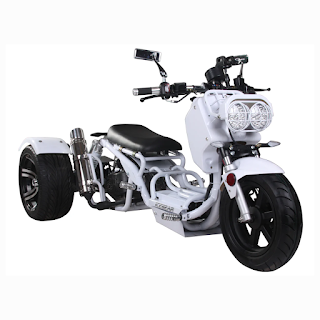What Are the Differences Between Gas-Powered and Electric Choppers for Kids?
When it comes to choosing a chopper for kids, parents often find themselves debating between gas-powered and electric models. Each type has its own set of advantages and drawbacks, making the decision a bit challenging. Understanding the key differences between gas-powered and electric chopper for kids can help you make an informed choice that best suits your child's needs and your family's preferences.
1. Power Source and Performance
Gas-Powered Choppers:Fuel Type: These choppers run on gasoline, similar to traditional motorcycles.
Performance: Gas-powered choppers typically offer higher speeds and more power. This makes them suitable for older kids who have experience with riding and can handle more advanced controls.
Range: They generally have a longer range per tank of gas compared to electric choppers, making them ideal for longer rides.
Electric Choppers:
Performance: Gas-powered choppers typically offer higher speeds and more power. This makes them suitable for older kids who have experience with riding and can handle more advanced controls.
Range: They generally have a longer range per tank of gas compared to electric choppers, making them ideal for longer rides.
Electric Choppers:
Fuel Type: Powered by rechargeable batteries.
Performance: Electric choppers are usually quieter and have a smoother acceleration. They are perfect for younger kids or beginners who are just starting to learn how to ride.
Range: The range is limited by the battery life, which means they are better suited for shorter rides and need frequent recharging.
Performance: Electric choppers are usually quieter and have a smoother acceleration. They are perfect for younger kids or beginners who are just starting to learn how to ride.
Range: The range is limited by the battery life, which means they are better suited for shorter rides and need frequent recharging.
2. Maintenance and Upkeep
Gas-Powered Choppers:Maintenance Needs: These require regular maintenance, including oil changes, fuel system checks, and spark plug replacements. The engine components can be more complex and may need professional servicing.
Durability: With proper maintenance, gas-powered choppers can be very durable and long-lasting.
Electric Choppers:
Durability: With proper maintenance, gas-powered choppers can be very durable and long-lasting.
Electric Choppers:
Maintenance Needs: Generally easier to maintain, with fewer moving parts. There’s no need for oil changes or fuel system maintenance.
Battery Care: The primary maintenance involves taking care of the battery, ensuring it’s charged properly, and occasionally replacing it after it wears out.
Battery Care: The primary maintenance involves taking care of the battery, ensuring it’s charged properly, and occasionally replacing it after it wears out.
3. Environmental Impact
Gas-Powered Choppers:Emissions: These produce emissions from burning gasoline, contributing to air pollution.
Fuel Use: Dependence on fossil fuels makes them less environmentally friendly compared to electric options.
Electric Choppers:
Fuel Use: Dependence on fossil fuels makes them less environmentally friendly compared to electric options.
Electric Choppers:
Emissions: Produce zero emissions during use, making them a greener choice.
Energy Source: The environmental impact depends on how the electricity used to charge the batteries is generated. Renewable energy sources can further reduce their carbon footprint.
Energy Source: The environmental impact depends on how the electricity used to charge the batteries is generated. Renewable energy sources can further reduce their carbon footprint.
4. Noise Level
Gas-Powered Choppers:Noise: Typically louder, producing engine noise similar to that of motorcycles. This can be a consideration if you live in a noise-sensitive area.
Electric Choppers:
Electric Choppers:
Noise: Much quieter, producing minimal noise. This makes them suitable for residential areas and for use in quieter neighborhoods.
5. Cost
Gas-Powered Choppers:Initial Cost: Often more expensive due to the engine and components.
Operational Cost: Regular fuel expenses and potentially higher maintenance costs.
Electric Choppers:
Electric Choppers:
Initial Cost: This can be less expensive upfront, especially for basic models.
Operational Cost: Lower ongoing costs, primarily related to electricity for charging and occasional battery replacement.
Operational Cost: Lower ongoing costs, primarily related to electricity for charging and occasional battery replacement.
6. Safety
Gas-Powered Choppers:Control and Handling: More power can mean more difficult handling, which might not be suitable for younger or inexperienced riders.
Fuel Safety: Requires careful handling and storage of gasoline.
Electric Choppers:
Fuel Safety: Requires careful handling and storage of gasoline.
Electric Choppers:
Control and Handling: Easier to control with smoother acceleration, making them safer for young riders.
Battery Safety: Requires proper charging practices, but is generally considered safe and easy to manage.
Battery Safety: Requires proper charging practices, but is generally considered safe and easy to manage.



Comments
Post a Comment